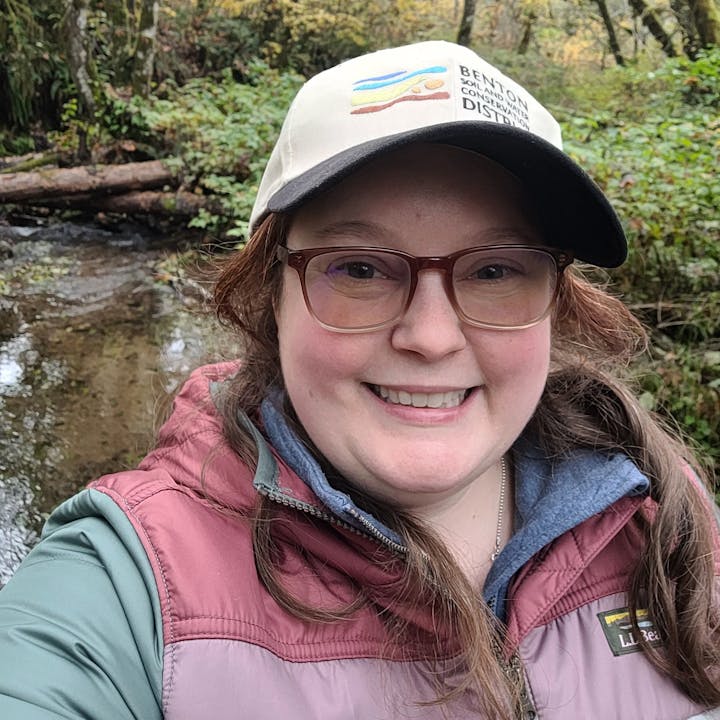The Dirt | Soil, Water, and Fire: Ethnobotany in Soap Creek

After a hot summer, we were finally beginning to feel hints of Fall in the air when we gathered at the historic schoolhouse in the small rural community of Soap Creek near Adair Village. We were here for an Ethnobotany Field Demonstration – a topic at the intersection of science, history, and culture. Sponsored by Luckiamute Watershed Council, and led by Greg Archuleta of the Confederated Tribes of Grand Ronde and Joe Scott of the Confederated Tribes of Siletz Indians, this event was provided free of charge thanks to funding from the Willamette Habitat Restoration Fund.
We were standing on lands inhabited by the Kalapuyan peoples since time immemorial. One participant asked Greg how he knew Native Americans used to live here – had they found artifacts or other evidence? He gave a broad sweep of his arm across the valley. “I can tell just by looking around,” he answered. With a natural spring, a pond, a marsh, and an oak savannah, this place was a bountiful home for the Kalapuya, providing ample fishing, hunting, and edible plants.
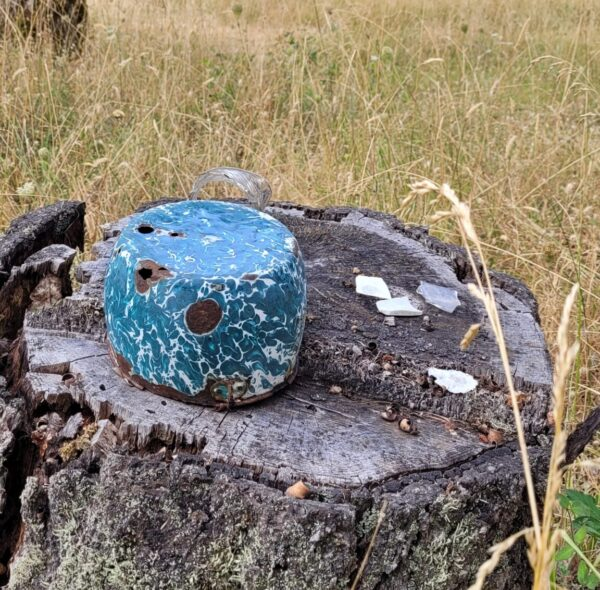
The settlers who arrived in the early 1900s recognized this bounty and established a logging camp, mill, and the restored schoolhouse we can see today. The Kalapuyans were forcibly removed from their ancestral homelands and disbanded to reservations across the Willamette Valley. White Oak savannahs were replaced with Douglas Fir stands; invasive blackberries smothered the Yampah and Camas. Suddenly, an ecosystem that had been carefully managed by the Kalapuyans and thrived for thousands of years was transformed. And with those changes came major change to an important piece of the ecological puzzle: fire.
Joe explained that these lands had been intentionally and expertly burned by indigenous people for as long as they could remember. These fires were specifically designed with our native bunchgrasses in mind, which burn very quickly but with flames that stay cool and low to the ground. This type of fire fostered a number of natural resources the people relied on: it stimulated acorn production, helped clear the way for edible bulbs to emerge, encouraged the Hazel stems used for weaving baskets to grow back straight and strong. It also created the Oak Savannahs which are an iconic and, unfortunately, dwindling part of the Willamette Valley landscape.
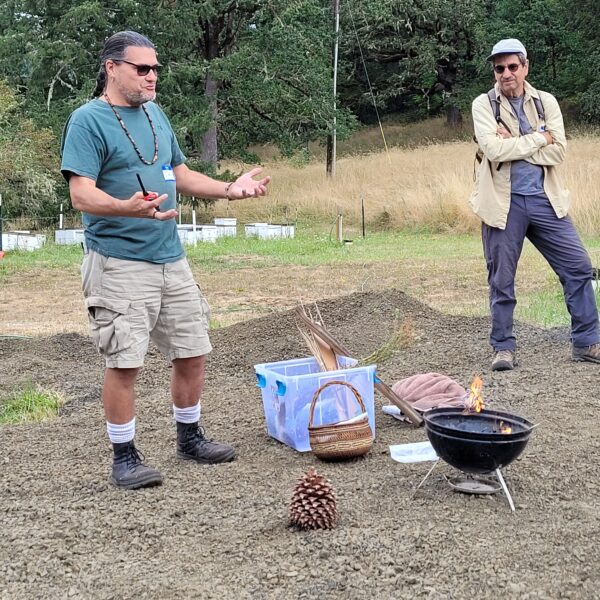
These fires were more than a way to provide food and tools – they were a vital part of the culture. The concept of “Good Fire” figures prominently in Grand Ronde and Siletz Tribal ceremonies, medicine, and traditions. Fires provided a number of ecosystem services as well. The charred brush decomposed into the soil, filling it with nutrients. This exposed, enriched soil was the perfect place for seeds to grow. The bunchgrass understory, kept sparse by routine fire, also allowed spring water to flow to the stream and eventually to the rivers; this cold, clear water was vital for salmon.

But when the new settlers arrived and shifted the landscape to timber farms, they considered fire the enemy. Fire was fought and suppressed, and the underbrush built up more and more. Until, when a fire did inevitably start, it spread catastrophically. Instead of working cooperatively with the natural patterns of the land as the Tribes had, the European settlers were constantly at war with the land, battling the ever-present threats of noxious weeds and accidental ignitions.
Today, Soap Creek neighbors including Faye Yoshihara, Kevin Kenaga, Janet Ohmann, and Joe Crockett, whose properties we were exploring, are working to restore their lands to the original ecosystems once inhabited by the Kalapuyans. With the help of Benton SWCD and other partners, these Soap Creek neighbors have begun restoring the oak savannah, marsh, and spring-fed pond. Douglas firs and blackberries have been cleared and native species such as Oceanspray, White Oak, and Roemer’s Fescue have been planted. It’s an ongoing process, but the land now resembles its historical state much more closely.
As we hiked through the bunchgrasses and then the dense spring-fed woodland, Joe and Greg pointed out a number of native species traditionally used by their peoples. Camas bulbs, a First Food staple, are harvested in early summer and eaten boiled or roasted in earthen ovens. Tarweed seeds are ground and used for flour – these are more easily collected after a fire, and the people would follow in the fire’s wake, knocking the seeds into baskets. The inner bark of Willows is used to make cords and baskets; Ash tree bark is used to make buckets and paddles. Wild rose hips and Licorice Fern were used as medicines to treat everything from stomachaches to coughs and fevers.
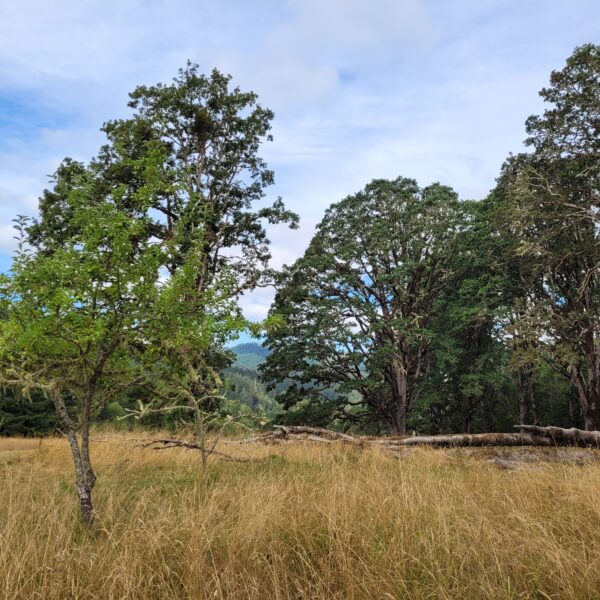
Kalapuyan ethnobotany is rich with stories, and like any society, it isn’t always just about survival. The flowers of Cat’s Ears are so sweet they were considered a candy, and Greg told us they often were stored in the rafters to keep them away from sweet-toothed children. Red Alders and Oregon Grape are used to make colorful dyes for clothing that figures in important ceremonies such as the welcoming of the First Salmon – a tradition that continues to this day. Cat-tails can be woven into mats, curtains, and hats. We paused at the marsh, where cat-tails swayed heavily in the breeze, to watch a party of bees make their way back and forth between the water and the prairie beyond.

This wetland has been restored by Soap Creek property owners and is seasonally flooded, providing needed moisture to the surrounding trees. Salmon may once have ventured here all the way from the sea.

These plants and hundreds of others, along with the elk, deer, beavers, and otters, formed a living pantry, grocery shop, and pharmacy for Indigenous peoples that we can only dream about today. “Pioneers called this place eden,” Joe told us. Standing on the crest of a hill dotted by giant Oaks, hearing the bluebirds call and seeing the marsh and mountains beyond, it was easy to imagine why both the Kalapuyans and Colonists considered this place such a paradise.
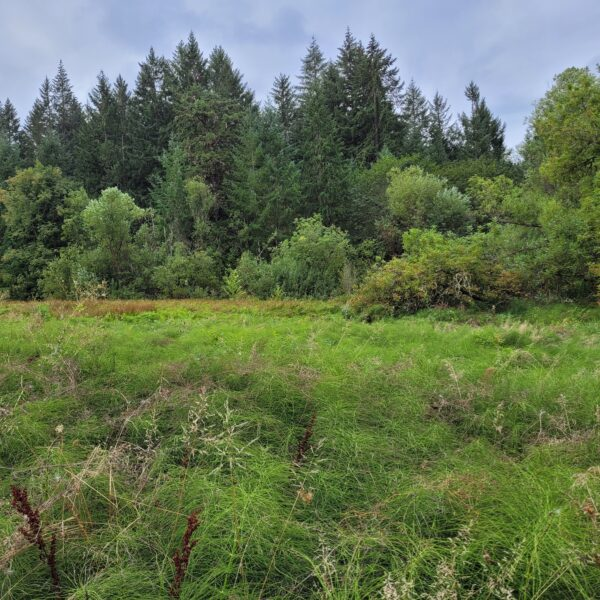
Like the Soap Creek community, we can all work to get closer to the eden that once existed in the Willamette Valley. Benton SWCD’s Natural Resource Conservation Program helps farmers, gardeners, and rural and urban residents to sustainably manage the lands we steward. By removing invasive species, planting natives, and learning from those who came before us, we can all play a part in restoring native waters, soils, and landscapes.

Special thanks to Suzanne Teller (Luckiamute Watershed Council), Greg Archuleta (Confederated Tribes of Grand Ronde), Joe Scott (Confederated Tribes of Siletz Indians), Faye Yoshihara, Kevin Kenaga, Janet Ohmann, and Joe Crockett for sharing their knowledge and allowing us to explore their lands!

